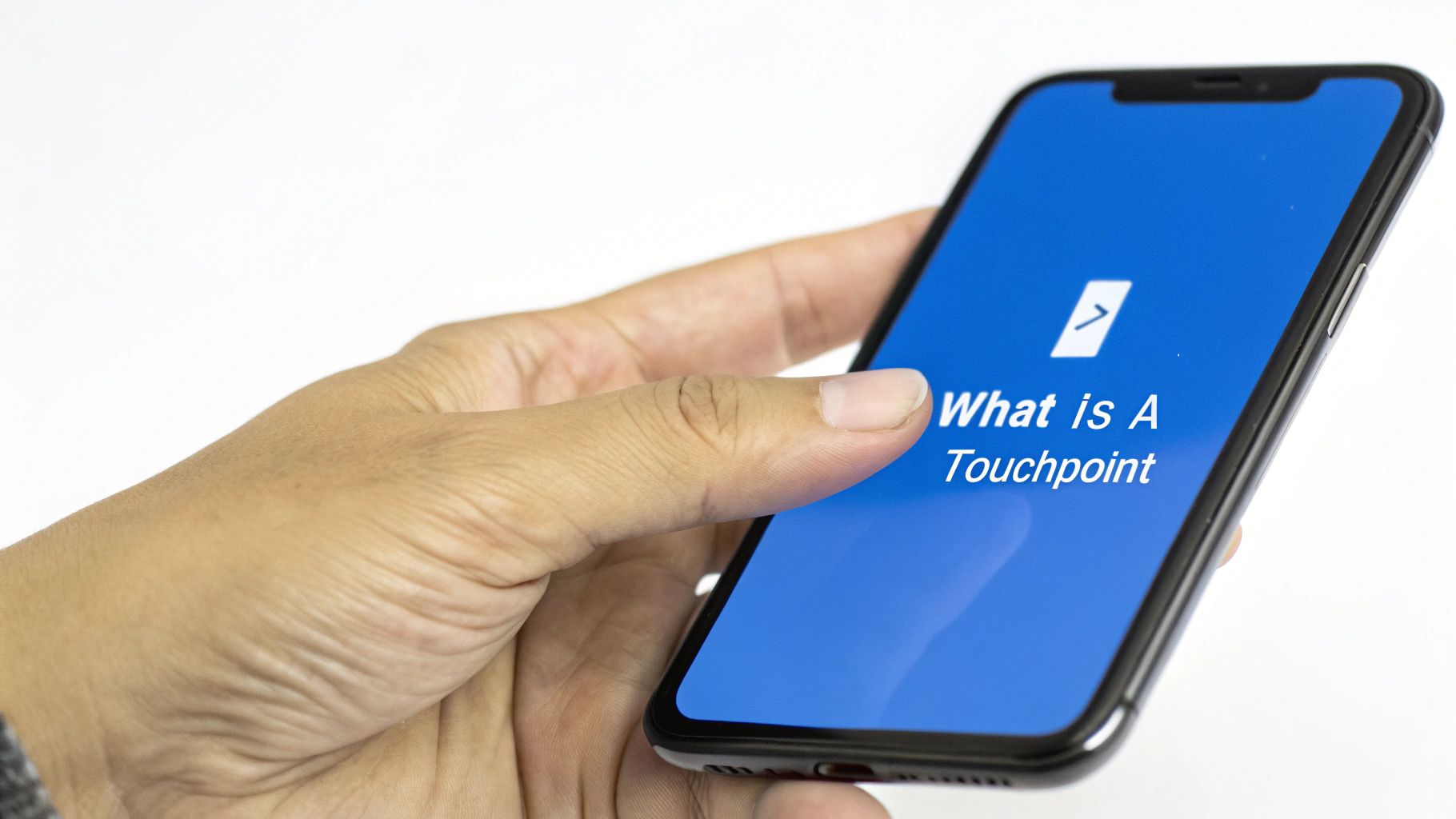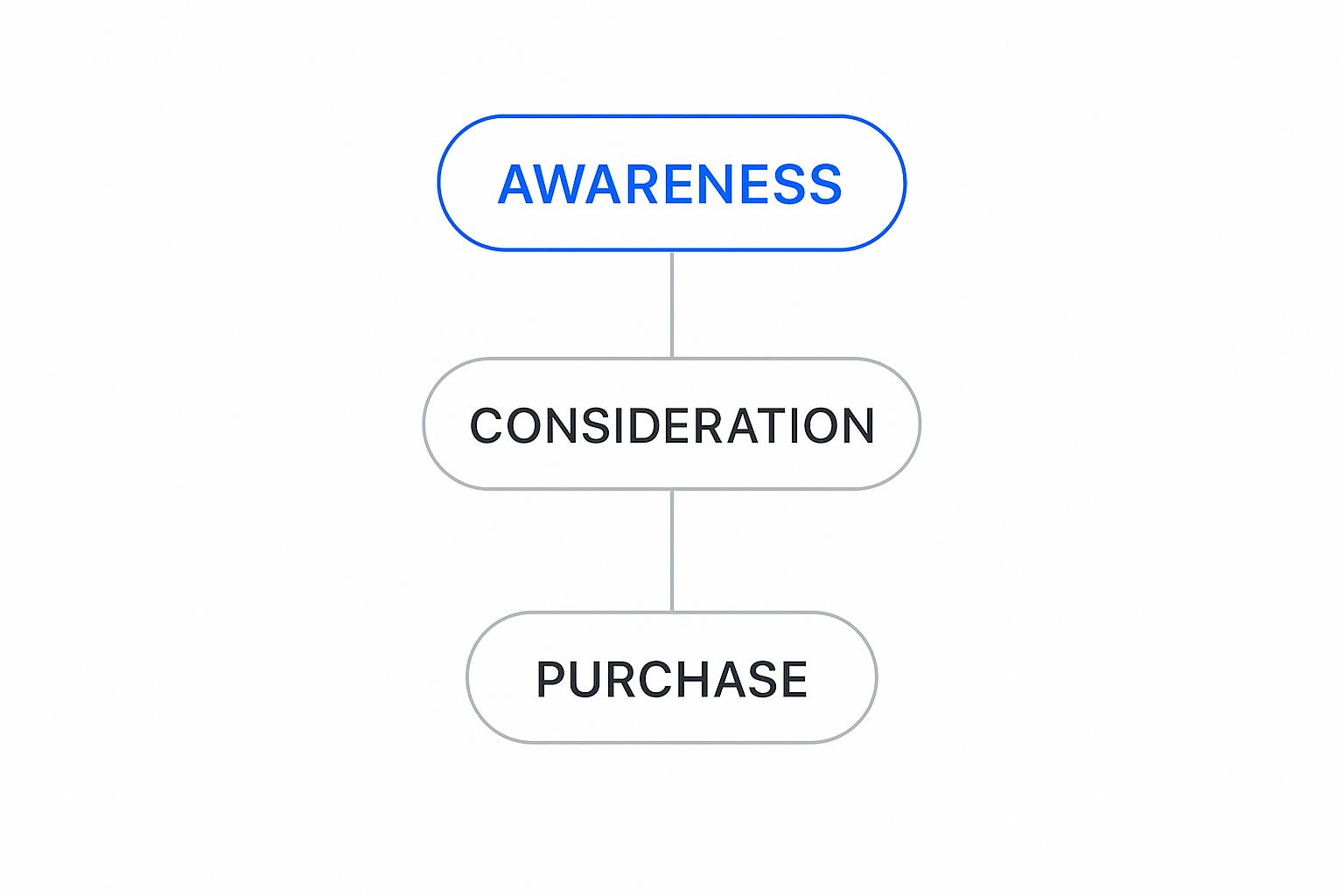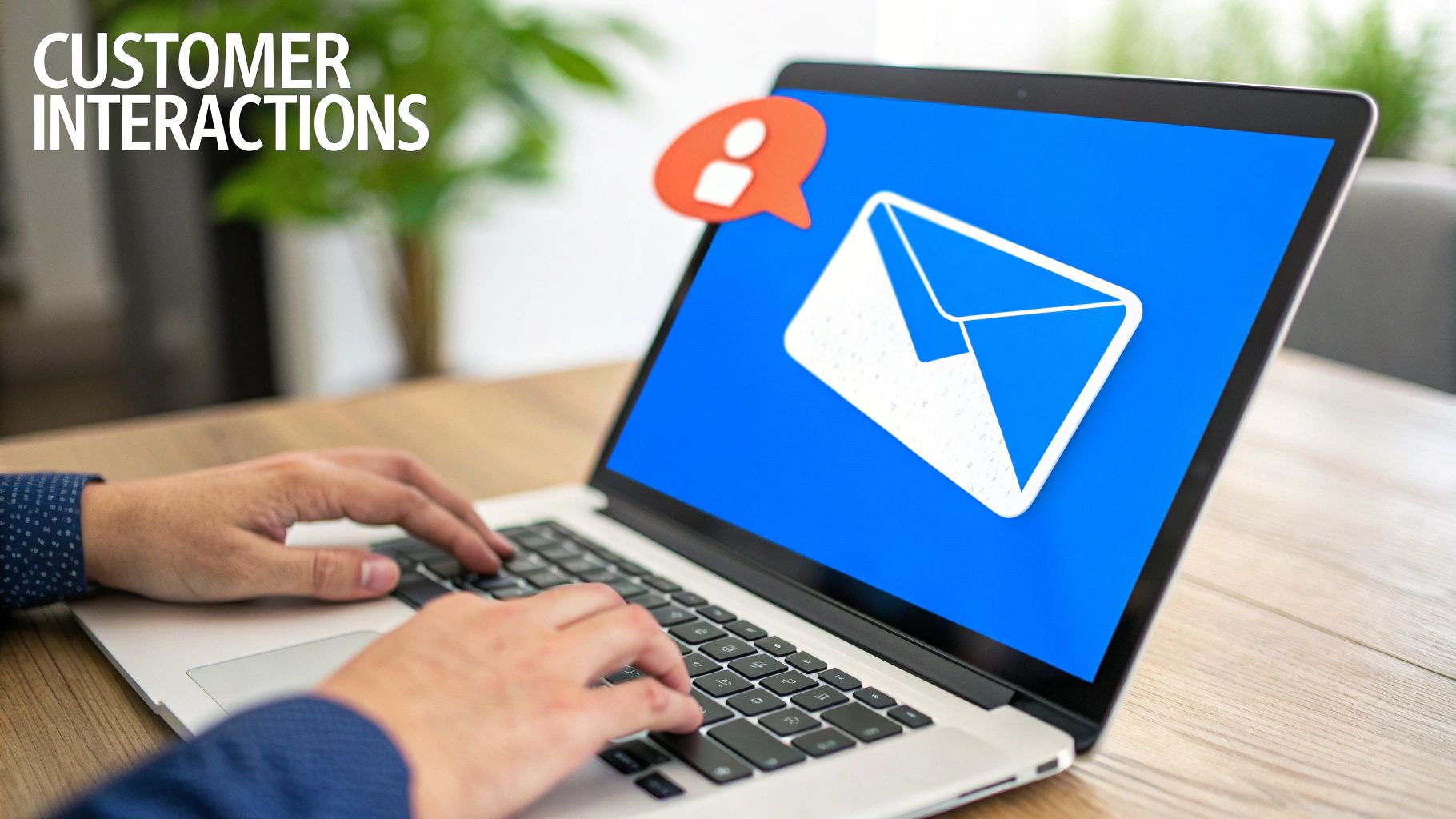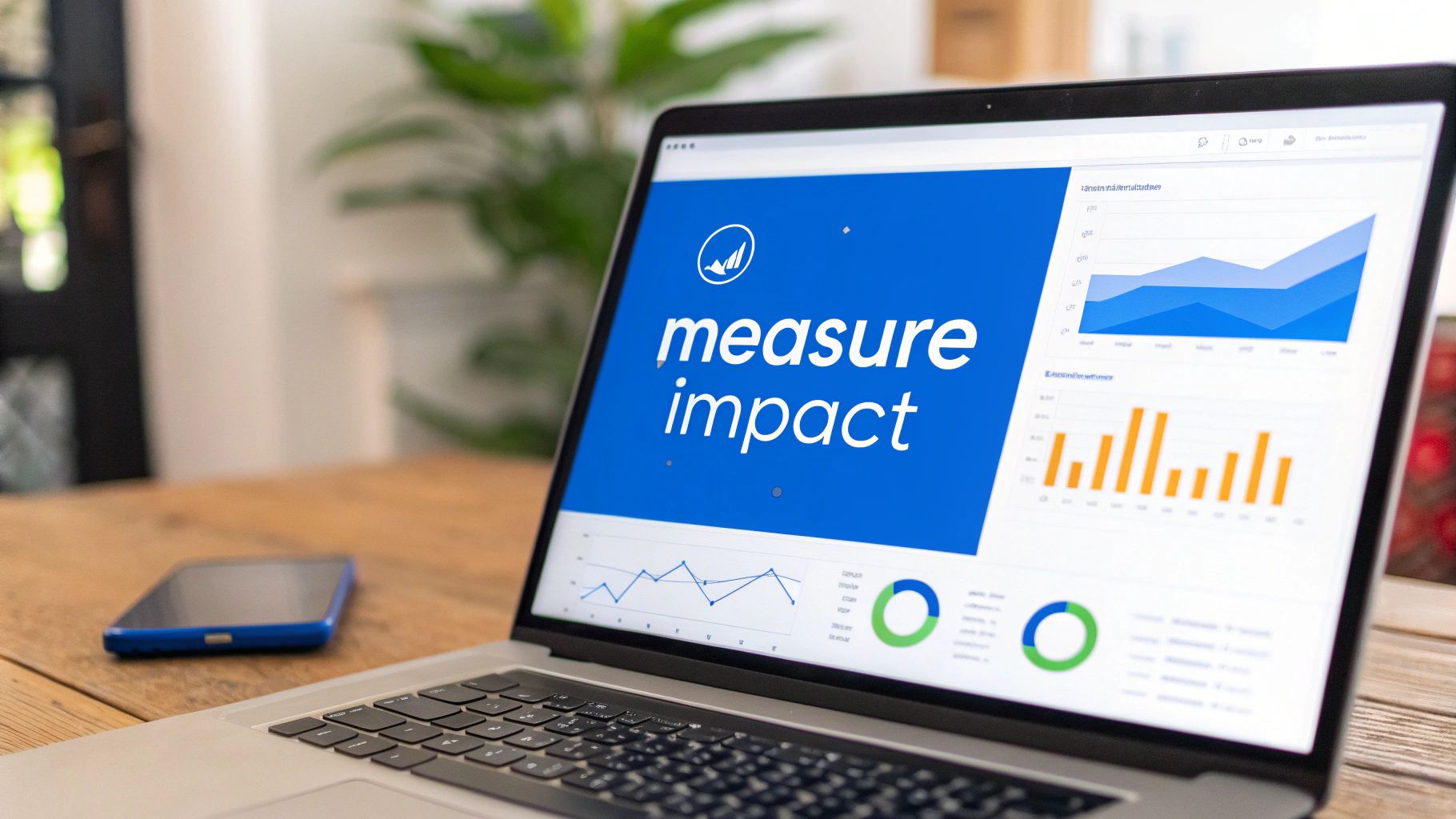A touchpoint is any interaction a customer or potential customer has with your brand. Think of it like a conversation; some chats are quick glances, like seeing an ad, while others are deep discussions, like a sales call. Each one shapes their opinion of you and guides them along their path to purchase.

Let’s try a different way of looking at it. Imagine your customer is on a cross-country road trip, and your brand is the ultimate destination. Along the way, they’ll see billboards (your ads), listen to the radio (podcasts mentioning you), and stop at gas stations (your website).
Each of these moments is a touchpoint. Some are brief and passive, while others are engaging and direct. All of them matter.
A touchpoint is any moment when a customer actively engages with a brand, whether through a physical interaction or a digital one. Every touchpoint contributes to the overall customer experience and brand perception.
These moments aren't just limited to the digital world. A touchpoint can be anything from clicking a social media ad to unboxing a physical product you shipped them. In modern marketing, every single interaction is an opportunity to make an impression.
For instance, a potential customer exploring sample event invitation email templates is a key interaction, happening long before they ever decide to attend. Understanding these diverse interactions is the first step toward seeing the full picture of your customer's journey. Our guide on customer journey touchpoints offers a deeper dive into this concept.
The sheer number of these interactions might surprise you. On average, a single purchase involves about 28.87 touchpoints. That number can swing wildly depending on the industry and the complexity of what you're selling. This is precisely why it’s so critical to map, track, and analyze every single point of contact.
To make this concept more concrete, let's break down the common types of touchpoints you'll encounter. The table below shows just how many ways customers connect with brands across different channels, both online and in the real world.
As you can see, the customer journey is far from a straight line. It's a web of interconnected experiences that, when managed correctly, lead people right to your doorstep.
Not all touchpoints are created equal. Some are designed to grab attention, others to close a sale, and still others to build loyalty after the fact. To really get a handle on their impact, it helps to organize them into three distinct stages that mirror the customer journey: Pre-Purchase, Purchase, and Post-Purchase.
Thinking this way turns a long, messy list of interactions into a strategic map. You can see the bigger picture and align your marketing efforts with specific goals, because each stage has its own job to do in moving a customer forward.
Here’s a simple way to visualize that journey:

The diagram breaks down how a customer moves from just hearing about you to actually buying something, showing the natural progression of their relationship with your brand.
This is the "discovery" phase. It’s where a total stranger first stumbles upon your brand and what you do. The whole point here is to make a great first impression—to catch their eye, spark some curiosity, and start building a little bit of trust.
Common pre-purchase touchpoints include:
Okay, so they know who you are and they're considering you as an option. Welcome to the purchase stage. The touchpoints here are all about one thing: turning that interest into a sale. Every interaction needs to be smooth, persuasive, and crystal clear.
A single point of friction during the purchase stage—like a confusing checkout page—can erase all the goodwill you built in the pre-purchase phase. Every detail matters.
This is where the rubber meets the road. Interactions during this critical stage include your website's pricing page, the checkout flow itself, a conversation with your sales team, or an interactive product demo. This is where the customer makes their final decision.
The journey isn’t over just because their payment went through. The post-purchase stage is where you transform a one-time buyer into a loyal fan. These touchpoints are all about ensuring customer satisfaction, encouraging repeat business, and building a long-term relationship.
This is also where you get the most valuable feedback. By analyzing customer interactions here, you can figure out which moments are most effective for creating true brand advocates and use those insights to refine your entire strategy.
Key post-purchase interactions are:

When you really dig into what a touchpoint is, you uncover a powerful truth about marketing: your brand isn’t what you say it is—it’s what your customers experience. Each interaction, no matter how small, adds a brushstroke to the picture they’re painting of your business. A seamless, positive experience across all these moments is what builds trust, loyalty, and, ultimately, revenue.
Think of it like building a personal reputation. You can have ten positive interactions that build immense goodwill. A potential customer might see a great ad, read a genuinely helpful blog post, and love your website's clean design. But just one significantly negative experience—like a painfully slow checkout process or a single frustrating support call—can erase all that progress in an instant.
The cumulative effect of all your touchpoints defines your brand. Inconsistent or negative interactions create friction and erode trust, while a consistently positive experience builds a brand people feel confident choosing and recommending to others.
Once you start seeing touchpoints as an interconnected system instead of a series of isolated events, your entire perspective shifts. A complete view of the customer journey lets you spot the friction points you never even knew existed. You might discover that one confusing sentence on your pricing page is causing more drop-offs than a poorly performing ad.
These insights are gold because they represent hidden opportunities to delight your customers. Fixing a small issue in the onboarding flow or simplifying a form can have an outsized impact on customer satisfaction and retention. This is where the strategic power of tracking touchpoints really comes into play.
Mapping and analyzing every touchpoint is about more than just fixing problems. It's about understanding which interactions have the biggest impact on the final sale. This is the bedrock of attribution, where you connect specific marketing actions to actual revenue.
For example, data shows that to close a deal in 2024, a B2B SaaS company needs an average of 266 touchpoints. Knowing which of those interactions are the most persuasive is what allows you to invest your time and money wisely. To see how this works in practice, it helps to understand the importance of attribution models in marketing, which determine how credit for a sale is assigned to different touchpoints along the way.
By connecting every interaction, you move from guesswork to a data-driven strategy. You can finally answer critical questions like, "Which blog posts are actually leading to sign-ups?" or "Did that webinar influence our biggest deals this quarter?" This transforms your understanding of what a touchpoint is from a simple definition into a powerful tool for growth.
Alright, so you understand what a touchpoint is and why it’s a big deal. Now for the fun part: putting that knowledge into action by creating a visual map of your customer’s experience. This process, known as customer journey mapping, is how you finally get to see your business through your customers' eyes. It’s where you’ll find all the opportunities to make things better.
This isn’t just some theoretical exercise. It's a hands-on method for finding friction points, spotting chances to delight your customers, and making sure their experience is smooth—from the very first ad they see to a support ticket they might file years down the road. The goal is to build out a detailed map for each of your key customer types.
Before you can map a journey, you need to know who’s actually on the trip. The first step is to get crystal clear on your target customer personas. Who are they, really? What are they trying to accomplish, and what headaches are they hoping you can solve?
To get this information, you’ll want to:
This research helps you build out detailed personas that feel like real people, giving you a sharp lens to view their entire journey.
With your personas locked in, it’s time to brainstorm every single interaction they could possibly have with your brand. Think chronologically across the three big stages: Pre-Purchase, Purchase, and Post-Purchase. No touchpoint is too small or insignificant to jot down.
Don’t just focus on the obvious digital interactions like your website or social media. Consider everything from your product’s packaging and billing invoices to how your team answers the phone.
You’ll end up with a long list of moments where your brand can either shine or fall flat. Some of these moments are more critical than others. For example, the initial onboarding experience is a make-or-break point for many businesses. To learn more, explore these SaaS onboarding best practices that can help you nail that first impression and boost user engagement from day one.
Now it’s time to organize all of this information into a customer journey map. A simple table is a fantastic way to get started. For each stage and touchpoint, you'll want to document what the customer is doing, how they're likely feeling, and where you see a chance to make things better.
Here’s a simplified template to give you an idea of what this looks like in practice.
Journey StageCustomer ActionTouchpointCustomer EmotionImprovement OpportunityPre-PurchaseSees a targeted ad for a solution to their problem.Facebook AdCurious, HopefulA/B test ad creative to improve click-through rate.PurchaseNavigates the checkout process.Website CheckoutAnxious, FocusedSimplify the form by removing non-essential fields.Post-PurchaseSeeks help for a technical issue.Support ChatFrustratedReduce response time and improve knowledge base.
This kind of visual map makes it incredibly easy to see where customers might be getting stuck or feeling frustrated. From here, you can start prioritizing improvements and begin to track the customer journey with much greater precision, ensuring you’re putting your effort into optimizing the moments that truly matter.

Mapping out your customer journey is a huge step forward. But a map is only useful if you know how to read it. It's one thing to identify a touchpoint; it's another thing entirely to prove its direct impact on your revenue. This is where most marketers start guessing, leaving them unsure which efforts are actually working.
To go from just knowing what a touchpoint is to truly understanding its value, you need a way to connect the dots. A platform like Cometly is built for this exact purpose. It closes the gap between your marketing activities and real-world sales, giving you undeniable proof of what’s driving your business forward.
Imagine trying to figure out which of your Facebook ads, TikTok videos, or Google search results led to a specific sale. Without the right tools, it’s a nearly impossible task. Cometly solves this by providing precise tracking that links every dollar of ad spend directly to revenue, turning abstract data into tangible results.
This data-first approach lets you:
Of course, to track and optimize your digital touchpoints effectively, it's crucial to implement website analytics. This foundational step provides the raw data needed for more advanced platforms to analyze and make sense of.
The heart of this entire process is revenue attribution, which is the science of assigning credit for a sale to the various touchpoints that influenced a customer. You can learn more about how this works by checking out our guide on https://www.cometly.com/post/what-is-revenue-attribution. This is the only way to calculate a true return on investment (ROI) for your marketing spend.
Marketers have debated for years how many touchpoints it takes to make a sale. The truth is, it depends. A completely cold prospect might need 20-50 interactions, while a warm lead may only require one to five. This huge variance is exactly why precise tracking is so critical for understanding real customer behavior.
By replacing assumptions with hard data, you get the certainty needed to make smart, strategic decisions. You’re no longer just creating touchpoints; you’re engineering a high-performance customer journey where every single interaction is measured, optimized, and held accountable for driving growth.
This is how you turn a simple understanding of "what is a touchpoint" into a powerful engine for your business.
As we've been unpacking the world of customer touchpoints, a few questions tend to pop up again and again. This section is all about getting you quick, clear answers to clear up any confusion and help you put these ideas into practice.
This is probably the most common mix-up, but the distinction is pretty simple. Think of a channel as the broad platform where you interact with customers—like social media, email, or your website. A touchpoint is the specific moment of interaction that happens on that channel.
Here’s an easy way to see it:
The channel is the "where," and the touchpoint is the "what." You can have dozens of touchpoints all taking place on a single channel.
If only there were a magic number! The truth is, it varies wildly depending on your industry, the price of your product, and who you're selling to. The journey for a $50 e-commerce product is worlds away from a six-figure B2B software deal.
However, recent data shows that in 2024, it takes an average of 266 touchpoints to close a B2B deal. That number alone should tell you just how complex the modern buyer's path has become.
A company with a deal size over $100,000 might see over 400 touchpoints, while a business closing deals under $10,000 could get by with around 50. The only way to know for sure is to track what's true for your business.
This is exactly why guessing doesn't work. You have to track your own customer journeys to find your baseline before you can even think about optimizing it.
Absolutely. A touchpoint is just an interaction—and interactions can be good, bad, or completely forgettable. A website that takes forever to load, a checkout process that’s a total headache, a rude customer support agent, or a misleading ad are all classic examples of negative touchpoints.
These moments of friction can undo all the hard work you put into creating positive experiences. A single bad interaction can easily erase the goodwill built up over ten good ones, which is why mapping your entire journey to find and fix these weak spots is so important.
While every interaction contributes to the overall customer experience, some moments definitely carry more weight than others. You'll want to prioritize tracking the "high-impact" touchpoints that most directly influence a customer's decision to buy.
These usually include:
Getting a handle on how these moments influence sales is the first step. The next is to learn how to measure marketing attribution, which provides the framework for assigning real value to each touchpoint along the way.
Ready to stop guessing and start knowing exactly which touchpoints drive your revenue? Cometly provides the clear, accurate attribution data you need to optimize your marketing spend and scale with confidence. Get started with Cometly today.
Learn how Cometly can help you pinpoint channels driving revenue.
.svg)
Network with the top performance marketers in the industry